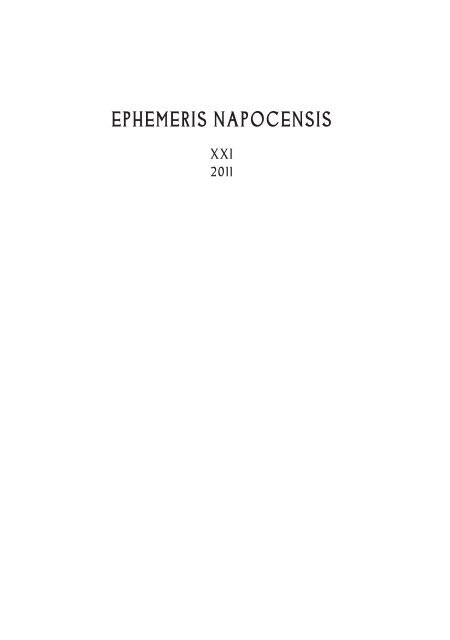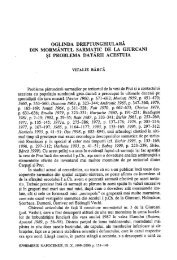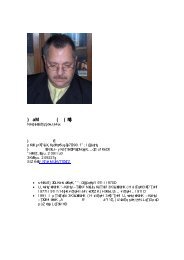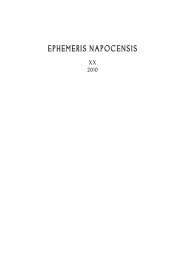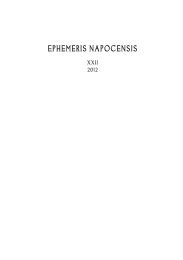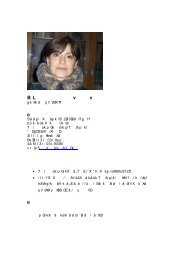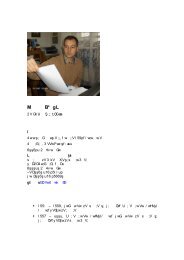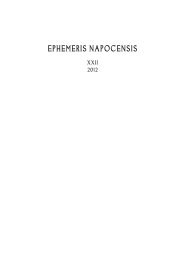ephemeris napocensis 2011 cu corectura.indd - Institutul de ...
ephemeris napocensis 2011 cu corectura.indd - Institutul de ...
ephemeris napocensis 2011 cu corectura.indd - Institutul de ...
Create successful ePaper yourself
Turn your PDF publications into a flip-book with our unique Google optimized e-Paper software.
EPHEMERIS NAPOCENSISXXI<strong>2011</strong>
SUMAR – SOMMAIRE – CONTENTS – INHALTSTUDIESVITALIE BÂRCĂThe Fibulae in the North-Pontic Sarmatian Environment (1 st Century – First Half of the 2 ndCentury AD) ......................................................................................................................7SORIN NEMETIIn cir<strong>cu</strong>itu tenuit … Dacia and Roman Geographical Knowledge ......................................37FLORIN FODOREANMapping the Orbis Terrarum: the Peutinger Map, the Antonine Itinerary and the CartographicTradition of the Fourth and Fifth Century AD .................................................................51FLORIN CURTAWerner’s Class I C: Erratum corrigendum <strong>cu</strong>m commentariis ...............................................63ARCHAEOLOGICAL AND EPIGRAPHICAL NOTESDAN AUGUSTIN DEACA Pharaoh Depiction from the Roman Province of Dacia ...............................................111MONICA GUIEvi<strong>de</strong>nce for Medical and Personal Care in the Case of the Roman Army in Dacia .........115BORDI ZSIGMOND LÓRÁND, RADU IUSTINIAN ZĂGREANUAuxilia from Olteni. Controversy and Interpretations .....................................................131CORIOLAN HORAŢIU OPREANUNew Approaches to the Knowledge of the Military Tile Stamps from the Auxiliary Forts ofDacia ..............................................................................................................................145SORIN BULZAN, CĂLIN GHEMIŞRoman Period Brooches from Să<strong>cu</strong>ieni Museum, Bihor County .....................................161REVIEWSALEKSANDR SIMONENKO, IVAN I. MARČENKO, NATALI’JA JU. LIMBERIS, RömischeImporte in sarmatischen und maiotischen Gräbern zwischen Unterer Donau und Kuban, (Archäologie inEurasien 25), Verlag Philipp von Zabern Mainz, 2008, 629 p., 57 fig., 14 maps, 390 pl., ISBN 978-3-8053-3954-4 (Vitalie Bârcă, Sorin Cociş) ..............................................................................171
Rome's World: the Peutinger map reconsi<strong>de</strong>red, Richard J. A. Talbert, University of North Carolina,Chapel Hill, In association with Tom Elliott, Assisted by Nora Harris, Gannon Hubbard,David O’Brien, and Graham Sheperd with a contribution by Martin Steinmann, CambridgeUniversity Press, 2010. Hardback. ISBN 978-0-521-76480-3, 376 pages, 33 b/w illus. 1 table.(Florin Fodorean) ......................................................................................................................185SZABÓ ÁDÁM, Dáciai papság, Budapest, editura Opitz, 2007, 270 p. (I sacerdozi nella dacia ms.)(Szabó Csaba) ............................................................................................................................196N. GUDEA, Castrul roman <strong>de</strong> la Feldioara. Încercare <strong>de</strong> monografie arheologică/Das Römerkastellvon Feldioara. Versuch einer archäologischen Monographie. Interferenţe etnice şi <strong>cu</strong>lturale înmileniile I a. Chr. – I p. Chr./Ethnische und Kulturelle Interferenzen in 1. Jahrtausend v. Chr. – 1.Jahrtausend n. Chr., Vol./Bd. 11, Ed. Mega (Cluj-Napoca 2008), 367 S., 28 + LXXIII Taf., 36 Abb.(Dan Matei) ..............................................................................................................................199Abbreviations that can not be found in Bericht <strong>de</strong>r Römisch-Germanische Kommission ...........207Gui<strong>de</strong>lines for Ephemeris Napocensis ........................................................................................211
EVIDENCE FOR MEDICAL AND PERSONAL CAREIN THE CASE OF THE ROMAN ARMY IN DACIA *Monica Gui **Abstract: The aim of this study is to bring forth the evi<strong>de</strong>nce from Dacia regarding medical and personalcare in the provincial army and to highlight all the strategies adopted to counter or avert illness, while at thesame time trying to avoid too much spe<strong>cu</strong>lation or generalisation (though examples from other provinces arerecalled). First the epigraphic data will be analysed: inscriptions mentioning medical personnel, collyriumstamps, votive monuments, but also their location (medical sanctuaries, spas). The second part is <strong>de</strong>dicatedto archaeological data, both architectural (valetudinaria, thermae) and artefactual (surgical and toiletinstruments). Since the latter category is the most consistent body of evi<strong>de</strong>nce, a more refined classification isattempted, as well as,wherever possible, an exten<strong>de</strong>d dis<strong>cu</strong>ssion on context, spatial distribution and patternsin use and <strong>de</strong>position.Keywords: medical care, hygiene, surgical and toilet instruments, Roman army, Dacia.1. IntroductionThe soldiers’ health was important for the Roman army, but there are still some problemswhen it comes to how the medical service was provi<strong>de</strong>d 1 .How formal was the medical corpsorganised? Did every troop had a doctor or were there regional health care centres? Furthermore,it must be remembered that the Roman army was not permanently engaged in combat, soperhaps there was no need for a doctor in every fort, at least not on a regular basis 2 .In thinking about Roman medicine, we tend to draw a line between the more rationalaspects (i.e. surgery, the use of medical treaties) and the irrational ones (i.e. appeal togods).However, the medical offer of the day inclu<strong>de</strong>d both rational and irrational forms of treatment,sometimes in conjunction, as people could seek help from doctors or gods, visit medical sanctuariesand spas. It seems that the physicians themselves did not refuse divine help 3 , so votive*This work was possible with the financial support of the Sectorial Operational Programme for HumanResources Development 2007–2013, co-financed by the European Social Fund, un<strong>de</strong>r the project numberPOSDRU/107/1.5/S/77946 with the title ‘Doctorate: an Attractive Research Career’.**Babeș-Bolyai University Cluj-Napoca, Romania; e-mail: monica.gui@ubbcluj.ro.1For an attempt to structure the medical corps (which inclu<strong>de</strong>d medici ordinarii, capsarii, optiones valetudinarii,the miles medi<strong>cu</strong>s etc. with different duties and <strong>de</strong>grees of medical knowledge), see DAVIES 1969.2BAKER 2000, 43, 154–156.3ALLASON-JONES 1999, 142; e.g. CIL III, 3413; AE 1998, 1134; see also JACKSON <strong>2011</strong>, 246–247,251. For inscription corpora, the following abbreviations will be used: AE = L’Année épigraphique; CIL = CorpusInscriptionum Latinarum, Berlin, 1863 sqq.; IDR = Inscripţiile Daciei Romane, Bu<strong>cu</strong>reşti/I, 1975 sqq.; ILD =C. C. Petoles<strong>cu</strong>, Inscripţii latine din Dacia, Bu<strong>cu</strong>reşti, 2005; RMD = Roman Military Diplomas, London, 1978 sqq.;Tab. Vindol. = A. K. Bowman, J. D. Thomas, The Vindolanda writing-tablets, 1983 sqq.Ephemeris Napocensis, XXI, <strong>2011</strong>, p. 115–130
116 Monica Guiinscriptions to medicine gods are also relevant for the subject. Unlike today, going to the doctorwas probably consi<strong>de</strong>red only when everything else failed, and people didn’t have many expectationsfrom the medici 4 . As a remin<strong>de</strong>r of just how much training a professional might have had isa funerary inscription from Drobeta mentioning a medi<strong>cu</strong>s legionis who died at the age of 23 5 . Asalways (but probably more important then), prevention is the best method of preserving one’shealth, and when it comes down to the Roman army, it can be seen right from the planning ofa fort 6 . At an individual level, this is achieved through personal hygiene (which is an importantpart of being ‘Roman’ as well). Its relevanceis stressed by the omnipresent thermae, and by thenumerous toilet implements that have entered the archaeological record.2. Doctors and gods, spas and medical sanctuariesOnly one physician is known in Dacia, from a 2 nd century funerary inscription foundin Drobeta, but his troop was not part of the regular provincial army. M. Valerius Longinus,<strong>de</strong>ceased at the age of 23, was med(i<strong>cu</strong>s) leg(ionis) VII Cl(audiae) 7 and arrived in Dacia with a<strong>de</strong>tachment of that legion during the Marcommanic wars 8 .The fact that he received honorarymembership in the town council of Drobeta suggests that he employed his skills for the localcommunity as well 9 . Apparently, the reverse is also true, meaning civilian doctors could practicemedicine in military hospitals 10 .Two o<strong>cu</strong>lists are recor<strong>de</strong>d, P. Cornelius Colonus and T. Attius Divixtus 11 , but they are notnecessarily associated with the army. As a strength report of the first Tungrian cohort fromVindolandain Britannia shows, illness could hin<strong>de</strong>r the activity of a troop and eye problems seem tobe of some concern 12 . Originating in Gaul, the majority of the signa<strong>cu</strong>la o<strong>cu</strong>lariorum were foundin the western provinces of the Empire 13 . Dacia, with only a couple discovered so far, conformsto the pattern and it is notable that one of the o<strong>cu</strong>lists bears a Gallic name. The two collyriumstamps cannot be assigned with certainty to a military context. Nevertheless, the services ofthe eye specialists who used them would have been readily available to the army, since one wasfound in Apulum, and the other in Gârbou (Sălaj county), not far from the northern limes. Ithas been suggested that, since it’s very unlikely every fort had such specialists, soldiers probablybought remedies from travelling o<strong>cu</strong>lists or pharmacists 14 , and this just might be the case ofColonus or Divixtus.The suffering could go to medical sanctuaries, well known in the Roman world. InDacia, a temple of this kind was archaeologically i<strong>de</strong>ntified in Ulpia Traiana Sarmizegetusa 15 .Many inscriptions <strong>de</strong>dicated to Aes<strong>cu</strong>lapius and Hygeia were found in the city, and among the<strong>de</strong>votees, one seems to be a mil(es) leg(ionis) VI, but the piece is now lost and it could have been4ALLASON-JONES 1999, 142–143.5CIL III, 14216.9 = IDR II, 42.6Vegetius, Epitoma rei militaris, III, 2.7CIL III, 14216.9 = IDR II, 42.8BENEA 1975.9DAVIES 1969, 87.10At least this was suggested on the basis of an epigraph (AE 1998, 1134) from Moesia Inferior, found in thevaletudinarium insi<strong>de</strong> Novae legionary fortress, <strong>de</strong>dicated by a simple medi<strong>cu</strong>s, without mentioning any militaryunit (APARASCHIVEI 2010, 144).11AE 1982, 837; CIL III, 1636 = IDR III/6, 431.12Tab. Vindol. II, 154; of the 296 men in garrison, 31 were unfit for service, 15 being sick (aegri), 6 woun<strong>de</strong>d(volnerati), and 10 suffering from eye inflammation (lippientes).13KÜNZL 1984, 167; RIHA 1986, 90.14ALLASON-JONES 1999, 137.15RUSU-PESCARU/ALICU 2000, 32–42.
Evi<strong>de</strong>nce for Medical and Personal Care in the Case of the Roman Army in Dacia117a fake 16 . Another Asklepeion must have functioned somewhere in Apulum, as a few inscriptionsrefer to it 17 . Some of those who commissioned votive monuments for medicine gods at this siteare connected with the military, like C. Iulius Frontonianus, veteran of the V Macedonica legionand former beneficiarius consularis 18 , Tib. Claudius Valerianus, centurion of the legions XIIIGemina and I Adiutrix 19 , or M. Memmius Longus, another beneficiarius, who fulfilled his vow tothe π 20 . Because C. Iulius Frontonianus thanked the gods for regaining his eyesight,it was assumed he received a medical or surgical treatment at the temple 21 . However, the smallquantity of surgical implements at the Asklepeion from Sarmizegetusa suggests that medicalprocedures probably took place elsewhere, temples being reserved mainly for consultations 22 .Related to the subject of medicine gods, it seems that statuettes were extremely rare in Dacia 23 .A bronze example believed to represent Hygeia was found in the auxiliary fort from Gherla, butthe i<strong>de</strong>ntification is not <strong>de</strong>emed certain 24 .Water therapy was recommen<strong>de</strong>d in several medical doctrines, since it was believedthat warm or cold baths would alleviate chest and back pains, pneumonia, headaches, painfuljoints, gout, fever, digestive disor<strong>de</strong>rs etc., or would balance the bodily humours 25 . Hence theimportance of thermal or mineral springs for treatment and recovery. A key factor in the <strong>de</strong>velopmentof spa facilities in the newly conquered provinces was the Roman army: because militaryhospitals were not meant to accommodate the convalescent or those needing a longer treatment,they could be sent off to this kind of resorts 26 . Several spas are known in Dacia, at Germisara(Geoagiu-Băi), Aquae (Călan) and Ad Mediam (Băile Her<strong>cu</strong>lane). An eloquent testimony onthe benefits of thermal waters comes from Ad Mediam, where a man <strong>de</strong>dicated an altar toAes<strong>cu</strong>lapius and Hygeia for the well-being of his wife, quod a longa infirmitate virtute aquarumnuminis sui revocaverunt 27 . Thus, the reason why a prefect of the legion from Apulum visitedthe resort and raised an altar for these gods 28 is no mystery. Some 50 years earlier, a veteran ofthe same unit set up a votive inscription for Her<strong>cu</strong>les 29 , the patron of this parti<strong>cu</strong>lar spring, alsohonoured by L. Pompeius Celer, prefect of the first Ubian cohort 30 . Germisara, in use sincepre-Roman times, was consi<strong>de</strong>red to be un<strong>de</strong>r the patronage of the Nymphs, and a nymphaeumwas i<strong>de</strong>ntified here 31 . The thermal facility was situated near the fort of Cigmău, garrisoned by anumerus singularium Britannicianorum 32 . None of the seven specta<strong>cu</strong>lar leaf-shaped gold sheetsfound here was <strong>de</strong>dicated by soldiers or by army or civil officials 33 . This was explained by thefact that, given their status, it was <strong>cu</strong>stomary and more appropriate even for simple soldiers to16CIL III, 1427 = IDR III/2, 167.17CIL III, 975 = IDR III/5.1, 6; CIL III, 976 = IDR III/5.1, 7; AE 1993, 1337 = IDR III/5.1, 13; CRIȘAN1971; see also RUSU-PESCARU/ALICU 2000, 123–125.18CIL III, 987 = ILS, 3847 = IDR III/5.1, 21; for a related inscription, see AE 1980, 735 = IDR III/5.1, 36.19CIL III, 981 = IDR III/5.1, 11.20CIL III, 7740a = IDR III/5.1, 15.21CRIȘAN 1971, 342.22ALICU/COCIȘ 1989, 226.23POP 1998 catalogued only one statuette <strong>de</strong>picting Aes<strong>cu</strong>lapius and one possibly Hygeia (240, cat. IV, C,no. 16; 241, cat. IV, C, 17), but both were consi<strong>de</strong>red dubious.24POP 1998, 241, no. 17.25JACKSON 1990, 1–4.26ALLASON-JONES 1999, 136; JACKSON 1990, 8–9.27CIL III, 1561 = IDR III/1, 55.28CIL III, 1560 = IDR III/1, 54.29CIL III, 1569 = IDR III/1, 61.30CIL III, 1571 = IDR III/1, 63.31PISO/RUSU 1990, 17; RUSU-PESCARU/ALICU 2000, 65–74.32GOSTAR 1956.33PISO/RUSU 1990, 10–13, nos. 1–7.
118 Monica Guiset up altars and statues instead 34 . In<strong>de</strong>ed, some of the altars from Germisara were <strong>de</strong>dicated tothe Nymphs or to Aes<strong>cu</strong>lapius and Hygeia by military personnel, like T. Fabius Aquileiensis 35 ,the tribune of the aforementioned numerus, P. Aelius Marcellinus, signifer et quaestor of the sametroop, whose life was saved 36 (possibly by treatment at the baths), or M. Aurelius Mosianus, optioof the XIII Gemina legion 37 . At Aquae, a veteran who probably came here for treatment set upa votive altar for Her<strong>cu</strong>les 38 .Apart from these inscriptions found in and around healing places, few others can berelated to the subject. One example is known on the northern limes: C. Iulius Atianus, prefectof the ala I Tungrorum Frontoniana, is thankful to Aes<strong>cu</strong>lapius and Hygeia ob rest[itutam sibivaletudinem] 39 . Of course, only the obvious epigraphs were mentioned, but others might have asimilar un<strong>de</strong>rlying significance. An interesting case is that of an inscription <strong>de</strong>dicated to IupiterOptimus Maximus Dolichenus ex praecepto num(inis) Aes<strong>cu</strong>lapi somno monitus by a veteran of theXIII th legion, p(ro) s(alute) s(ua) suor(um)q(ue) 40 . The association of Dolichenus with Aes<strong>cu</strong>lapiusindicates that the former was un<strong>de</strong>rstood as having healing powers 41 and perhaps this parti<strong>cu</strong>laraspect of the divinity was being consi<strong>de</strong>red here for safeguarding the family’s good health.In conclusion, there is hardly any evi<strong>de</strong>nce that the rank and file were going to sanctuariesor spas. Maybe it’s just an acci<strong>de</strong>nt of inscription survival or they expressed their gratitu<strong>de</strong> in otherways. Or, it could be that, apart from a few veterans who se<strong>cu</strong>red for themselves a higher socialstanding, simple soldiers didn’t have access to places frequented by provincial governors, legionaryor auxiliary comman<strong>de</strong>rs, other officers and civil officials. Still, the votive monuments give us aglimpse of the way these people might have perceived medical treatment. It is beyond doubt theywere well aware of the <strong>cu</strong>rative effects of thermal waters and we can suspect some un<strong>de</strong>rwent actualmedical or surgical procedures. It is easy to imagine, for example, C. Iulius Frontonianus sufferingfrom cataract and seeing again after an operation. Cataract extraction, although requiring someskills and great care, was pretty straightforward and had a high success rate 42 . So, while someancient medical texts do make a distinction between rational and irrational forms of medicine 43 ,for these people it is all too clear that the gods are responsible for their regained health.3. Closer to the forts: thermae and valetudinariaIt is safe to assume that every fort had thermae, and some have been excavated, likethe military baths from Slăveni 44 , Micia 45 , Inlănceni 46 , Mehadia 47 , Romita 48 , Potaissa 49 etc. Itappears that only a small quantity of archaeological material is known from these sites, eitherbecause it hasn’t been fully published, or it’s largely missing due to later human or natural<strong>de</strong>struction. However, the finds from Romita do give us an i<strong>de</strong>a on the kinds of small things34PISO/RUSU 1990, 14.35PISO/RUSU 1990, 16–17, no. 11 = ILD, 329 = AE 1992, 1487.36CIL III, 1396 = IDR III/3, 243.37AE 1993, 1341 = ILD, 319.38CIL III, 1406 = IDR III/3, 8.39CIL III, 786.40CIL III, 1614 = IDR III/5.1, 220.41POPA/BERCIU 1978, 9–10.42JACKSON 1986, 151; JACKSON <strong>2011</strong>, 257.43Celsus, De Medicina, Prooemium.44POPILIAN 1971.45MARINESCU/MĂRGHITAN/PETOLESCU 1975.46GUDEA 1979, 167–170.47MACREA/GUDEA/MOȚU 1993, 69–74.48MATEI/BAJUSZ 1997.49BĂRBULESCU/CĂTINAȘ/LUCA/HUSAR/HUSARIK/GREC/BĂRBULESCU1999.
120 Monica Guito surgeons (e.g. the handle from Gilău was <strong>de</strong>corated with silver inlay). This is probably alsotrue for some small knives found at Porolissum-Pomet 60 (Pl. I/3). More numerous are theforceps tweezers 61 , which were used for extracting foreign bodies, holding and lifting skin ortissue etc. 62 The forceps consi<strong>de</strong>red are of the pointed-jawed (Pl. I/7), smooth-jawed (Pl. I/6)or toothed-jawed types and some have sli<strong>de</strong>-rings for fixation.One pair is of a rarer type, beingcombined with a scoop probe 63 (Pl. I/8). Another double forceps with interlocking teeth andsli<strong>de</strong>-ring has been discovered in the legionary fortress of trajanic date at Berzobis (Caraș-Severincounty), this one ending with a blunt hook 64 . Sharp hooks were used as retractors for woundsand incisions, being essential to the surgeon 65 . Although common in the rest of the Empire, onlyone has been published from the military sites in Dacia 66 (Pl. I/4).The presence of a physicianor a pharmacist is suggested by a fragment of a cylindrical copper alloy box found at Bologa 67(Pl. I/10), of the type used to store probes and needles or collyria 68 . Another find from the samefort is a tuff palette with the name Denecio scratched on the back; this person was consi<strong>de</strong>reda military o<strong>cu</strong>list 69 , but the writing might as well relate to the owner. It seems that during theexcavations in the fort of Drobeta, a surgical set turned up 70 , but to my knowledge the pieceshaven’t been published.Archaeological discoveries from different parts of the Empire show that a simple toiletset was basically ma<strong>de</strong> up of a pair of tweezers and an ear pick (ligula probe), sometimes a nailcleaner 71 . Most of the so-called ‘medical instruments’ from the Roman forts of Dacia are exactlytweezers and various types of probes, so at least some could actually be toiletry.Several cosmetic tweezers (with a length of less than 10 cm) have been found 72 . Themajority are extremely simple, ma<strong>de</strong> of a single strip of metal. It should be noted that these werealso commonly used in the household, as lamp accessories for putting out the fire or handlingthe wick 73 . By far, the largest in numbers are the different kinds of probes and spatulas. Thesetoo could be employed in all sorts of activities that have nothing to do with medicine or hygiene,like mixing paints or <strong>de</strong>corating ceramic vessels, as seen in a potter’s workshop from the ruralsettlement of Micăsasa 74 .The ear probe 75 (specillum ori<strong>cu</strong>larium or ligula), a slen<strong>de</strong>r stem endingwith a small angled plate, was used for medical investigations as well as for extracting cosmetics60GUDEA/BAJUSZ 1992, 254, nos. 6–8, Pl. I/6–8.61GUDEA/BAJUSZ 1992, 259, nos. 13–14, Pl. V/13, 14 (Buciumi); nos. 1–2, Pl. VI/1, 2 (Porolissum-Pomet); COCIȘ 1993, 241, no. 1, Fig. 1/1 = PROTASE/GUDEA/ARDEVAN 2008, 88, no.1, Pl. XLII/1 (Gherla).62JACKSON 1986, 137–139; JACKSON <strong>2011</strong>, 254–255.63GUDEA/BAJUSZ 1992, 259, no. 2, Pl. VI/2.64FLUTUR/FLUTUR 2007, 75–76, Pl. I, II.65JACKSON 1986, 139; JACKSON <strong>2011</strong>, 256; MILNE 1907, 85–87.66GUDEA/BAJUSZ 1992, 259, no. 3, Pl. VI/3 (Porolissum-Pomet).67GUDEA/BAJUSZ 1992, 264, no. 7, Pl. X/7.68KÜNZL 1984, 166; JACKSON 1986, 137, Fig. 5/36, 37; MILNE 1907, 169–171, Pl. LIII.69GUDEA 1997b, 60.70BENEA 1975, 306.71CRUMMY 1983, 61–62, nos. 141–145, Fig. 67 (Colchester); RIHA 1986, 26, Pl. 9/71–73 (AugustaRaurica); another such set is illustrated by MILNE 1907, Pl. XXVI/4; though the nail cleaners are typically Romano-British.72POP 1997, 36, no. 217 (Ilișua); GUDEA/BAJUSZ 1992, 258–259, nos. 2, 10, 12, Pl. V/2, 10, 12 (Buciumi);258, nos. 4, 6, 7, Pl. V/4, 6, 7 (Porolissum-Pomet); DIACONESCU/OPREANU 1987, 59, no. 22, Fig. 3/22(Gilău); BONDOC/GUDEA 2009, 234, nos. 739–740, Pl. CXIX/739 (Răcari).73ALICU/COCIȘ 1989, 226; MILNE 1907, 92.74ALICU/COCIȘ 1989, 223.75GUDEA/BAJUSZ 1992, 261, nos. 2, 7, Pl. VIII/2, 7 (Porolissum-Pomet); 261, no. 3, Pl. VIII/3 (Buciumi);BĂRBULESCU 1997, Fig. 26/5 (Potaissa).
Evi<strong>de</strong>nce for Medical and Personal Care in the Case of the Roman Army in Dacia121or medicaments from their containers 76 . The most numerous are the spathomele 77 (Pl. I/5),double-en<strong>de</strong>d, with an olivary expansion and a spatula, used for wound examination, as tongue<strong>de</strong>pressors, for preparing and applying pharmaceutical and cosmetic substances, or paint 78 . Afew cyathiscomele have also been found 79 (Pl. I/8). They are similar to spathomele, only instead ofa spatula have a scoop probe, and were used as <strong>cu</strong>rettes or for extracting different substances 80 .Apart from these, excavations in the forts yiel<strong>de</strong>d other less common types 81 .Medicaments and cosmetics were grin<strong>de</strong>d and prepared on small rectangular stonepalettes. Many of those found in the Empire have obvious wear marks because of that; somehave worn edges, pointing to the sharpening of scalpels 82 . Tuff or slate pallets appear to bethe most frequent finds from the military milieu in Dacia that can be associated with medicalpractices 83 . This is probably because, unlike other implements, they were manufactured locally 84and were of a lesser value.Less ambiguous when it comes to function are a few toilet object like strigils, combs,mirrors or razors. The strigils, associated with going to the baths, were often carried on a ring,together with a pan and an oil flask 85 . Few are recor<strong>de</strong>d in Dacia, the majority of which werefound in forts 86 . The most interesting is that from barrack no. 5 from Buciumi, with the name ofthe maker inscribed on the insi<strong>de</strong> of the handle 87 . Some apparently triangular razors have beenfound 88 and from the legionary fortress of Potaissa there is a fine example of a framed zoomorphic76ALICU/COCIȘ 1989, 224; ALLASON-JONES 1999, 141; CRUMMY 1983, 51; KÜNZL 1984, 176;MILNE 1907, 55–56.77POP 1997, 36, no. 218 (Ilișua); GUDEA/BAJUSZ 1992, 255, nos. 5–7, Pl. II/5–7; 256, nos. 6, 9–11,Pl. III/6, 9–11; 258, no. 14, Pl. IV/14 (Porolissum-Pomet); 255, nos. 8, 3, Pl. II/8, III/3; 256, no. 7, Pl. III/7;probably also CHIRILĂ/GUDEA/LUCĂCEL/POP 1972, Pl. CX/14 (Buciumi); MATEI/BAJUSZ 1997, 127,Pl. LXXXI/1 (Romita); COCIȘ 1993, 242, no. 11, Fig. 2/7 (Tibis<strong>cu</strong>m); note that a great number are fragments andso the i<strong>de</strong>ntification can’t be 100% certain.78ALICU/COCIȘ 1989, 223; ALLASON-JONES 1999, 141; CRUMMY 1983, 63; KÜNZL 1984, 171;MILNE 1907, 57–60.79GUDEA/BAJUSZ 1992, 257, no. 6, Pl. IV/6 (Buciumi); MATEI/BAJUSZ 1997, 127, Pl. LXXXI/2(Romita); GUDEA/BAJUSZ 1992, 255, no. 1, Pl. III/1, probably the same with GUDEA/POP 1971, 59,Pl. LVII/1 (Râșnov – Cumidava); TUDOR/DIACONESCU/POPILIAN 1967, 593, 598, Fig. 4/9 = BONDOC2005, 140, no. 3, Fig. 3 (Cioroiul Nou).80ALLASON-JONES 1999, 141; MILNE 1907, 61–62.81GUDEA/BAJUSZ 1992, 256, no. 8, Pl. III/8; 257, no. 8, 9, Pl. IV/8, 9; 258, no. 12, Pl. IV/13; 262, nos.8, 9, 11, Pl. VIII/8, 9, 11 (Porolissum-Pomet); 257, nos. 4, 12, Pl. IV/4, 12; 264, no. 10, Pl. X/10 (Buciumi);DIACONESCU/OPREANU 1987, 58–59, no. 20, 22, Fig. 3/20, 22 (Gilău); MATEI/BAJUSZ 1997, 129,Pl. LXXXII/3 (Romita); BONDOC/GUDEA 2009, 235, no. 737, CXIXa/737, (Răcari).82MILNE 1907, 171.83GUDEA/BAJUSZ 1992, 266, no. 1, Pl. XIV/1; 267, nos. 4, 6, 7, Pl. XIV/4, 6, 7; 267, nos. 1, 2, 4, 5,Pl. XV/1, 2, 4, 5; 267, no. 1, Pl. XVI/1; 268, nos. 2–4, Pl. XVI/2–4; 268, no. 2, Pl. XVII/2 (Porolissum-Pomet);267, no. 5, Pl. XIV/5; 268, nos. 1, 3, Pl. XVII/1, 3; CHIRILĂ/GUDEA/LUCĂCEL/POP 1972, 82, nos. 1–3,Pl. CXXIV/2 (Buciumi); GUDEA 2008, 233, nos. 8, 9, Pl. LXXIII/8, 9 (Feldioara); BONDOC/GUDEA 2009,235–236, no. 748, Pl. CXX/748 (Răcari); BONDOC 2005, 141, no. 8, Fig. 8 (Cioroiul Nou); PRIBAC/TIMOC2004, 167, Pl. I/1 (Tibis<strong>cu</strong>m).84GUDEA/BAJUSZ 1992, 251.85JACKSON <strong>2011</strong>, Pl. 49; RIHA 1986, 23, Abb. 1.86PROTASE/GUDEA/ARDEVAN 2008, 88, no.1, Pl. XLIII/1, (Gherla); GUDEA/BAJUSZ 1992, 264–265, nos. 1, 2, Pl. XI/1, 2 (Buciumi); 265, no. 3, Pl. XII/3; MATEI/BAJUSZ 1997, 127, Pl. LXXXI/3 (Romita);BĂRBULESCU 1997, Fig. 26/3 (Potaissa).87CHIRILĂ/GUDEA/LUCĂCEL/POP 1972, 81, no. 1, Pl. CXII/1 = GUDEA/BAJUSZ 1992, 264, no. 1,Pl. XI/1; the Greek inscription reads π.88BONDOC/GUDEA 2009, 236–237, nos. 755–756, Pl. CXXI/755–756; this type appears to be a prettyearly one, popular among simple soldiers (for types of razors see BOON 1991).
122 Monica Guirazor 89 . It’s hard to tell wheter the 16 cm long iron shears (forfex) from Răcari 90 were used for<strong>cu</strong>tting human hair or not 91 . Since combs were usually ma<strong>de</strong> of wood until the end of the 3 rdcentury 92 , they are pretty rare, and it should be noted that all the examples from Dacia are suspicious93 . Mirrors, except for the richly <strong>de</strong>corated ones, are common toilet objects used by men andwomen alike 94 , so it’s not surprising that a few ma<strong>de</strong> their way into the archaeological record 95 .The last category to be analysed is that of household itemslabelled ‘surgical’ in someof the cited studies 96 . Admittedly, physicians could, and probably did use some of them forconsultations or surgery. However, the primary function of these objects is very different. Thatdoesn’t make them seem out of place in a Roman fort, so there is no reason why they should beautomatically called ‘medical instruments’. This is the case of the spoons, generally consi<strong>de</strong>reddomestic utensils 97 . Archaeology and ancient literary sources prove that the round-bowledcochlearwas used for eating eggs, while its pointed handle served to extract shellfish from theirshells 98 . Most of the spoons from military sites in Dacia (whether ma<strong>de</strong> of bone, copper alloy oriron) belong to this type 99 , although some examples with pear-shaped or mandolin-shaped bowlappeared as well 100 . Of an unknown type is a silver spoon from Ilișua 101 . The rarer ligula, similarto mo<strong>de</strong>rn spoons, is also illustrated 102 . The various copper alloy needles 103 can be seen assewing(and not necessarily surgical) needles. An interesting point though is that they were used institching bandages or dressing, so their association with medical implements is not unusual 104 .Regarding versatility and multi-purpose, another interesting case is that of styli. Sometimes theinstruments found in Dacia were mistaken for probes 105 , but their sharp tip and characteristic89BĂRBULESCU 1997, Fig. 26/1; a very similar example is illustrated by BOON 1991, Fig. 3/f.90BONDOC/GUDEA 2009, 236, no. 75191It seems shears were not usually used for this purpose (see BOON 1991, 26, note 2) and even small pairs arerare among medical instruments (KÜNZL 1984, 166), so this parti<strong>cu</strong>lar example might be a tool of some sort.92CRUMMY 1983, 55; RIHA 1986, 20.93A bone comb with semi-cir<strong>cu</strong>lar handle was published from Gherla (ALICU/COCIȘ 1993, 119, nr. 106)as an import, but in reality is a Germanic artifact from the area of the <strong>cu</strong>ltures Przeworsk, or Wielbark fromNorthern Europe, dating from the stages B2–C1 as C. Opreanu <strong>de</strong>monstrated (OPREANU 1998, 109–111); twocopper alloy fragments i<strong>de</strong>ntified as combs are known from Răcari (BONDOC/GUDEA 2009, 236, nos. 749, 750,Pl. CXX/749, 750), but their teeth are rather large and maybe they had a different use.94RIHA 1986, 11.95BONDOC/GUDEA 2009, 236, nos. 752–754, Pl. CXXI/752–754 (Răcari); BĂRBULESCU 1997,Fig. 26/2 (Potaissa).96Most of the ‘instrument handles’ published by GUDEA/BAJUZ 1992 were left out, since it’s not certain theybelonged to medical implements, and, in fact, a few suspiciously resamble strap terminals (see pl. XIII).97RIHA/STERN 1982, 10; for a similar classification see CRUMMY 1983, 69–70.98Martial, Epigrams, XIV, CXXI; a spoon from Augusta Raurica stil had a fragment of an egg shell attached toit (RIHA/STERN 1982, 10–11); see also CRUMMY 1983, 69; cf. PRIBAC/TIMOC 2004, 169 who (wrongly)believe that the sharp pointed stem was inserted into a bone or woo<strong>de</strong>n handle.99GUDEA/BAJUSZ 1992, 263, nos. 2, 3, Pl. X/2, 3 (Porolissum-Pomet); 263, no. 1, Pl. X/1 (Buciumi) MACREA/GUDEA/MOȚU 1993, 112, no. 1, Pl. XXXI/1 (Mehadia); MATEI/BAJUSZ 1997, 129, Pl. LXXXII/4 (Romita);PROTASE/GUDEA/ARDEVAN 2008, 86, no. 4, Pl. XXXV/4 (Gherla); BĂRBULESCU 1997, Fig. 27/1 (Potaissa).100GUDEA/BAJUSZ 1992, 263, no. 7, Pl. IX/7 (Porolissum-Pomet); nos. 1, 4, Pl. IX/1, 4 (Buciumi).101POP 1997, 36, no. 214.102GUDEA/BAJUSZ 1992, 262–263, no. 5, Pl. IX/5 (Porolissum-Pomet); 263, nr. 6, Pl. IX/6 (Buciumi);BĂRBULESCU 1997, Fig. 25/5 (Potaissa).103GUDEA/BAJUSZ 1992, 260, nos. 2, 4, 5, 8–10, Pl. VII/2, 4, 5, 8–10; 261, nos. 11, 12, Pl. VII/11, 12(Porolissum-Pomet); CHIRILĂ/GUDEA/LUCĂCEL/POP 1972, 81, nos. 1, 2, 4, 5, Pl. CX/2, 8, 11, 13 (Buciumi);BONDOC/GUDEA 2009, 235, nos. 745–747, Pl. CXX/745–747 (Răcari).104MILNE 1907, 75–76.105E.g., a copper alloy stylus from Porolissum-Pomet was published as a probe (GUDEA/BAJUSZ 1992,257, no. 11, Pl. IV/11), while an almost i<strong>de</strong>ntical piece from Răcari was later i<strong>de</strong>ntified as a writing instrument(BONDOC/GUDEA 2009, 228, no. 674, Pl. CXIII/647).
Evi<strong>de</strong>nce for Medical and Personal Care in the Case of the Roman Army in Dacia123eraser means that this function can’t be completely ruled out. Furthermore, there is reason tobelieve that a stylus, especially an iron one, could occasionally serve as cautery 106 .Fort MI M/TI M/DO MI? TI Total %Porolissum-Pomet 8 29 13 6 1 57 43.18Buciumi 2 19 8 2 2 33 25Gilău 2 2 4 3.03Gherla 1 1 3? 5 3.78Bologa 1 1 2 1.51Ilișua 2 1 3 2.27Romita 3 1 1 5 3.78Feldioara 2 2 1.51Cumidava 1 1 0.75Tibis<strong>cu</strong>m 2 2 1.51Mehadia 1 1 0.75Răcari 4 4 7? 15 11.36Cioroiul Nou 2 2 1.51Total 14 67 29 8 14 132% 10.60 50.75 21.96 6.06 10.60Fig. 1. Types of objects found in auxiliary forts; MI = medical implements (scalpels, forceps, small knives, hooks), M/TI = medical/toilet implements (probes, spatulas, tweezers, palettes), M/DO = medical/domestic objects (needles,spoons), MI? = medical implements? (un<strong>de</strong>termined), TI = toilet implements (strigils, combs, mirrors, razors).For the first table (Fig. 1), only the surgical and toilet instruments recor<strong>de</strong>d as discoveredin forts were consi<strong>de</strong>red. Apart from these, a lot of similar implements from the militaryenvironment are known, such as scalpels, spatulas, probes, tweezers or spoons from places likeIlișua, Micia, Apulum, Porolissum, Tibis<strong>cu</strong>m, Gilău or Cioroiul Nou, but their exact find spotis uncertain; other pieces were found in the military vici 107 or in towns, as for example at UlpiaTraiana Sarmizegetusa 108 .Find spot MI M/TI M/DO MI? TI Total %barrack no. 5 1 1 5 1 1 9 27.27section XXVI 1 1 3.03barrack no. 2 6 2 8 24.24barrack (?) 3 3 9.09barrack no. 3 1 1 2 6.06barrack no. 4 2 2 6.06principia 2 2 6.06barrack no. 1 1 1 3.03section I 1 1 3.03unknown 3 1 4 12.12Total 2 19 8 2 2 33% 6.06 57.57 24.24 6.06 6.06Fig. 2. Buciumi – spatial distribution.106JACKSON 1986, 155.107For implements from these sites, see IGNA 1936; DUMITRAȘCU 1983; GUDEA/BAJUSZ 1992; COCIȘ1993; COCIȘ/ALICU 1993 PROTASE/GAIU/MARINESCU 1997, Pl. LXXV/11–13; PRIBAC/TIMOC 2004;BONDOC 2005.108ALICU/COCIȘ 1989.
124 Monica GuiAs the table indicates, the majority of the finds come from the auxiliary forts ofPorolissum-Pomet and Buciumi, on the northern frontier. There is no point in making a quantitativecomparison between sites, as the numbers are obviously <strong>de</strong>pen<strong>de</strong>nt on the extent of theexcavations and on the publication of the material. Still, it should be noted that there is hardlyany fort that has not yiel<strong>de</strong>d at least one implement of this sort, no matter how scarcely investigated.Only about 10% are undoubtedly medical, while more than 70% fall in the ambiguouscategory of medical/toilet/domestic objects.These observations, corroborated with the wi<strong>de</strong>distribution of this kind of artefacts in civil settlements (and throughout the Empire for thatmatter) support the hypothesis that most are toilet or pharmaceutical objects and in themselvesdo not prove the existence of physicians 109 . Of course, this is not to say that they weren’t anintegral part of a surgeon’s or general practitioner’s instrumentarium. However, it is important toconsi<strong>de</strong>r the categories separately, as specialised instruments indicate more clearly the presenceof professional medici.Only in two cases was there possible to consi<strong>de</strong>r the spatial distribution of artefactswithin forts. As shown by table no. 2 (Fig. 2), most of the material from Buciumi was discoveredin the barracks (75.75%), apparently in all their phases 110 . It can be argued that the excavationstook place especially in the barrack blocks and most importantly, not all of the structures wereliving quarters. Nevertheless, it seems clear just how many medical/toilet implements were inthe possession of the soldiers.Find spot MI M/TI M/DO MI? TI Total %water cistern 3 5 1 1 10 17.54building C4 2 4 2 1 9 15.78building C2 1 5 1 7 12.28building C5–7 1 2 3 5.26porta praetoria, on the road 1 1 1.75garbage dump, latus <strong>de</strong>xtrum 1 1 1.75baracks(?), praetentura sinistra 1 1 1.75principia 3 1 4 7.01via principalis 3 3 5.26porta praetoria, N tower 1 1 1.75interval tower, NW si<strong>de</strong> 1 1 1.75N corner tower 1 1 1.75near building C2, latus <strong>de</strong>xtrum 1 1 1.75on the vallum, section 46, NW si<strong>de</strong> 1 1 1.75in front of the wall 1 1 1.75section II/1985, NW si<strong>de</strong> 1 1 1.75unknown 1 3 6 1 11 19.29Total 9 28 13 6 1 57% 15.78 49.12 22.80 10.52 1.75Fig. 3. Porolissum-Pomet – spatial distribution.At Porolissum-Pomet the situation is rather different (Fig. 3). The majority of the findswith a known location are almost evenly distributed between the water tank (17.54%) andbuildings C4 (15.78%) and C2 (12.28%). In all of these places, the rate of medical and medical/109JACKSON <strong>2011</strong>, 258; MILNE 1907, 60; KÜNZL 1984, 161 with respect to tweezers; a scoop probe and astone palette <strong>de</strong>posited in a woo<strong>de</strong>n box were found in tomb from Potaissa (MILEA/HOPÂRTEAN/LUCA 1978)and since there is no indication it was a surgeon’ s burial, it can be assumed the items were toilet objects associatedwith the <strong>de</strong>ceased.110GUDEA/BAJUSZ 1992, 252.
Evi<strong>de</strong>nce for Medical and Personal Care in the Case of the Roman Army in Dacia125toilet implements is the highest. The last two structures were consi<strong>de</strong>red a praetorium, respectivelya valetudinarium or a second praetorium 111 . It is certainly conceivable that the equestriancomman<strong>de</strong>rs had their own personal doctors who followed them in their short commissions.However, it is also stated that in C4 there were dozens of bone arrows which were probablymanufactured on the spot, for and by the archers in garrison 112 . Had the barracks been thefo<strong>cu</strong>s of investigations, probably the quantity of finds recovered would be similar to that fromBuciumi. More interesting is the <strong>de</strong>position of a great number of instruments (including twoscalpels and a toothed forceps) in the alleged water cistern abandoned at the beginning of the3 rd century and used there on as a garbage dump 113 . A lot of these were actually in quite a goodcondition. Since they were so formally discar<strong>de</strong>d, there is a possibility of being associated witha certain person or illness, and thus consi<strong>de</strong>red contaminated 114 . An interesting parallel is seenin the legionary fortress of Vindonissa, where approximately 19% of the 326 implements werefound in a dump area, while the rest were scattered all over the fort 115 .Even though a site-by-site quantitative comparison is generally useless, the case of theauxiliary ala fort from Ilișua is most interesting. Rather extensive mo<strong>de</strong>rn excavations have beencarried out and at least five barracks were investigated 116 . Just three medical implements wererecovered, two from the barracks and one from the praetorium 117 . This is striking when comparedwith the barracks form Buciumi, or with the finds from the cavalry fort in Gilău. Only a verysmall quantity of material was published from the latter site, but already several surgical instrumentswere noted 118 . A study on medical care for the army on the western frontiers has shownthat the least evi<strong>de</strong>nce is to be found in Nori<strong>cu</strong>m and Pannonia Inferior, and this seems not tobe exclusively due to the limited excavations; it might actually mark a <strong>cu</strong>ltural difference 119 . Asimilar situation could be envisioned in the case of the ala I Tungrorum Frontoniana, which wastransferred from Pannonia Inferior and is known to have started recruiting locally prior to itsarrival in Dacia 120 . Admittedly, this is stretching the imagination a bit too far, since ala Silianafrom Gilău came from the same province after all, and on the same occasion. However, differencesare obvious, leaving some clues of regional variation.V. ConclusionsWhile by no means lacking, the evi<strong>de</strong>nce for an organised medical system in the Romanforts from Dacia is not so conclusive either 121 . Certainly, the typical surgical implements discoveredpoint to professional medical care, be it provi<strong>de</strong>d by troop physicians or by the comman<strong>de</strong>rs’personal medici. Notably, medical kits or more specialised items of a doctor’s instrumentarium(like <strong>de</strong>ntal pincers, <strong>cu</strong>pping vessels or gynaecology instruments) haven’t been found so far inthe province 122 . However, it must be acknowledged that material remains are not necessarily111GUDEA 1997a, 24–25.112GUDEA 1997a, 63.113GUDEA 1997a, 41.114BAKER 2004, 8–9.115BAKER 2004, 9–11.116PROTASE/GAIU 1999, 418 state that five barracks were excavated, but their plan (Fig. 3) shows seven.117MARCU 2006, 465, note 39; unpublished, the items could be the silver spoon, small tweezers and flatspatula mentioned by POP 1997, 36, nos. 216–218.118See DIACONESCU/OPREANU 1987.119BAKER 2000, 143–146.120The ri<strong>de</strong>rs attested in Pannonia Inferior inclu<strong>de</strong> a Scordis<strong>cu</strong>s (CIL III, 3400) and an Eravis<strong>cu</strong>s (RMD V, 345),while the equites known from Dacia have Thracian names (CIL III, 799, 809; ILD, 799).121However, we must not forget the large quantity of implements that sadly remain unpublished.122COCIŞ 2003; provincial background probably plays a role in this situation, as epigraphic and artefactualevi<strong>de</strong>nce is more compelling in the neighbouring province of Moesia Inferior, with a rich medical tradition datingback to the Hellenistic period (APARASCHIVEI 2010).
126 Monica Guireliable in this case 123 . When need arose, it was not unusual to use whatever came in handy,even items hardly recognisable as medical, although starting from the first century AD there isa gradual increase of purpose-ma<strong>de</strong> instruments 124 . Besi<strong>de</strong>s, ancient text mention a variety ofimplements ma<strong>de</strong> of glass, wood or other organic materials that have not survived; furthermore,one might suspect there were a lot of fine iron implements, like cauteries or bla<strong>de</strong>s, which, overtime, became corro<strong>de</strong>d beyond recognition 125 . What is apparent though is the prevalence ofpersonal care and hygiene, which is surprising only if we forget that, apart from being effectivepreventive methods, were equally important for being (or trying to be) ‘Roman’.REFERENCESALICU/COCIȘ 1989D. ALICU/S. COCIȘ, Instrumentele medicale <strong>de</strong> la Ulpia Traiana Sarmizegetusa. Apulum 26,1989, 223–236.APARASCHIVEI 2010D. APARASCHIVEI, Being a Physician in Moesia Inferior. Dacia 54, 2010, 157–175.ALLASON-JONES 1999L. ALLASON-JONES, Health Care in the Roman North. Britannia 30, 1999, 133–146.BAKER 2000P. BAKER, Medical Care for the Roman Army on the Rhine, Danube and British Frontiers inthe First, Second and Early Third Centuries AD. PhD thesis, University of Newcastle upon Tyne(Newcastle 2000).BAKER 2004P. BAKER, Roman Medical Instruments: Arcaheological Interpretations of their Possible ‘Nonfunctional’Uses.Social History of Medicine 17/1, 2004, 3–21.BĂRBULESCU 1997M. BĂRBULESCU, Castrul legionar <strong>de</strong> la Potaissa (Turda) (Zalău 1997).BĂRBULESCU/CĂTINAȘ/LUCA/HUSAR/HUSARIK/GREC/BĂRBULESCU 1999M. BĂRBULESCU/A. CĂTINAȘ/C. LUCA/A. HUSAR/P. HUSARIK/M. GREC/C. BĂRBULESCU, The Baths of the Legionary Fortress at Potaissa. In N. Gu<strong>de</strong>a (edit.),Roman Frontier Studies. Proceedings of the XVII th International Congress of Roman FrontierStudies(Zalău 1999), 431–441.BENEA 1975D. BENEA, Un medic al legiunii a VII Claudia la Drobeta în timpul războaielor marcomanice.Sargetia 11–12, 1975–1975, 303–306.BONDOC 2005D. BONDOC, Atestări arheologice ale practicilor medicale romane la Cioroiul Nou, ju<strong>de</strong>țulDolj. Drobeta 15, 2005, 138–147.BONDOC/GUDEA 2009D. BONDOC/N. GUDEA, Castrul roman <strong>de</strong> la Răcari. Încercare <strong>de</strong> monografie(Cluj-Napoca2009).BOON 1991G. C. BOON, ‘Tonsor Humanus’: Razor and Toilet-Knife in Antiquity. Britannia 22, 1991,21–32.123JACKSON <strong>2011</strong>, 268 points out that there was no material evi<strong>de</strong>nce of medical practices in the Vindolandaforts and vici, but the writing tablets mention a medi<strong>cu</strong>s (Tab. Vindol. II, 156), a valetudinarium (Tab. Vindol II,155), patients and afflictions (Tab. Vindol. II, 154), remedies (Tab. Vindol. II, 294) and pharmacists (Tab. Vindol.III, 586).124JACKSON <strong>2011</strong>, 249.125JACKSON 1986, 120, 155; JACKSON <strong>2011</strong>, 250; MILNE 1907, 56; glass stirring rods, for example, werefound in Augusta Raurica (RIHA 1986, Taf. 16–17).
Evi<strong>de</strong>nce for Medical and Personal Care in the Case of the Roman Army in Dacia127CHIRILĂ/GUDEA/LUCĂCEL/POP 1972E. CHIRILĂ/N. GUDEA/V. LUCĂCEL/C. POP, Castrul roman <strong>de</strong> la Buciumi. Contribuții lacercetarea limesului Daciei Porolissensis (Cluj 1972).COCIȘ 1993S. COCIȘ, Instrumente medicale din Dacia romană. Apulum 27–30, 1993, 241–249.COCIȘ 2003S. COCIȘ, Medical Instruments in Roman Dacia. In L. Pet<strong>cu</strong>les<strong>cu</strong> (edit.), Antique Bronzes inRomania. Exhibition Catalogue (Bucharest 2003), 63.CRIȘAN 1971I. H. CRIȘAN, Asklepeionul roman <strong>de</strong> la Apulum.Apulum 9, 1971, 341–346.CRUMMY 1983N. CRUMMY, Colchester Archaeological Report 2: The Roman Small Finds from Excavationsin Colchester 1971–9. Colchester Archaeological Report 2 (Colchester 1983).DAVIES 1969R. W. DAVIES, The Medici of the Roman Armed Forces.Epigraphische Studien (Düsseldorf1969), 83–99.DIACONESCU/OPREANU 1987A. DIACONESCU/C. OPREANU, Bronzuri romane din castrul <strong>de</strong> la Gilău. StCercIstorV38/1, 1987, 52–71.DUMITRAȘCU 1983S. DUMITRAȘCU, O trusă <strong>de</strong> instrumente medicale (chirurgicale) romane <strong>de</strong>scoperită laAlba-Iulia. Apulum 21, 1983, 111–114.FLUTUT/FLUTUR 2007A. FLUTUR/L. FLUTUR, O pensetă medicală și un bronz din castrul Bersobis. AnaleleBanatului 15, 2007, 75–83.GOSTAR 1956N. GOSTAR, Inscripții și monumente din Germisara.Sargetia 3, 1956, 57–99.GUDEA 1979N. GUDEA, Castrul roman <strong>de</strong> la Inlănceni (încercare <strong>de</strong> monografie).ActaMusPorol 3, 1979,149–269.GUDEA 1997aN. GUDEA, Castrul roman <strong>de</strong> la Moigrad-Pomet. Porolissum 1(Zalău 1997).GUDEA 1997bN. GUDEA, Castrul roman <strong>de</strong> la Bologa-Res<strong>cu</strong>lum (Zalău 1997).GUDEA 2008N. Gu<strong>de</strong>a, Castrul roman <strong>de</strong> la Feldioara. Încercare <strong>de</strong> monografie arheologică (Cluj-Napoca2008).GUDEA/BAJUSZ 1991N. GUDEA, I. BAJUSZ, Ace <strong>de</strong> păr din os <strong>de</strong> la Porolissum. ActaMusPorol 14–15, 1990–1991,81–126.GUDEA/BAJUSZ 1992N. GUDEA/I. BAJUSZ, Instrumente medicale şi ustensile folosite <strong>de</strong> medicii şi farmaciştiiromani din Dacia Porolissensis. Contribuţii la studiul medicinei romane. ActaMusPorol 16,1992, 249–291.GUDEA/POP 1971N. GUDEA/I. I. POP, Castrul roman <strong>de</strong> la Rîșnov-Cumidava. Contribuții la cercetarea limesului<strong>de</strong> sud-est al Daciei romane (Brașov 1971).IGNA 1936N. IGNA, Instrumente chirurgicale romane găsite la Apulum. Anuarul <strong>Institutul</strong>ui <strong>de</strong> StudiiClasice II, 1933–1935 (Cluj 1936), 223–227.JACKSON 1986R. JACKSON, A Set of Roman Medical Instruments from Italy. Britannia 17, 1986, 119–167.
128 Monica GuiJACKSON 1990R. JACKSON, Waters and Spas in the Classical World. Medical History, Suppl. 10, 1990, 1–13.JACKSON <strong>2011</strong>R. JACKSON, Medicine and Hygiene. In L. Allason-Jones (ed.), Artefacts in Roman Britain.Their Purpose and Use (Cambridge <strong>2011</strong>), 243–268.KÜNZL 1984E. KÜNZL, Medizinische Instrumente <strong>de</strong>r Römerzeit aus Trier und Umgebung. TrZ 47, 1984,153–237.MACREA/GUDEA/MOȚU 1993M. MACREA/N. GUDEA/I. MOȚU, Praetorium. Castrul și așezarea romană <strong>de</strong> la Mehadia(Bu<strong>cu</strong>rești 1993).MARINESCU/MĂRGHITAN/PETOLESCU 1975L. MARINESCU/L. MĂRGHITAN/C. C. PETOLESCU, Thermele romane <strong>de</strong> la Micia.Raport asupra săpăturilor din anii 1971–1974. CercA 1, 1975, 217–229.MARCU 2006F. MARCU, The Valetudinarium at Ilișua. In C. Găzdac, C. Gaiu (eds.), Fontes historiae. Studiain honorem Demetrii Protase (Bistrița 2006), 461–470.MATEI/BAJUSZ 1997A. MATEI/I. BAJUSZ, Castrul roman <strong>de</strong> la Romita (Zalău 1997).MILEA/HOPÂRTEAN/LUCA 1978Z. MILEA/A. HOPÂRTEAN/C. LUCA, Noi contribuții privind necropola romană <strong>de</strong> laPotaissa.ActaMusNapoca 15, 1978, 201–206.MILNE 1907J. S. MILNE, Surgical Instruments in Greek and Roman Times (Oxford 1907).OPREANU 1998C. H. Opreanu, Dacia romană și Barbari<strong>cu</strong>m (Timișoara 1998).PISO/RUSU 1990I. PISO/A. RUSU, Nymphaeum-ul <strong>de</strong> la Germisara. Revista Monumentelor Istorice 59 (1),1990, 9–17.POP 1997C. POP (edit.), Miles Romanus in provincia Dacia. Catalogul expoziției naționale (Cluj-Napoca1997).POP 1998C. A. POP, Bronzuri figurate în Dacia romană. PhD Thesis, Babeș-Bolyai University. (Cluj-Napoca 1998).POPA/BERCIU 1978A. POPA/I. BERCIU, Le <strong>cu</strong>lte <strong>de</strong> Jupiter Dolichenus dans la Dacie Romaine. EPRO 69 (Lei<strong>de</strong>n1978).POPILIAN 1971G. POPILIAN, Thermele <strong>de</strong> la Slăveni. Apulum 9, 1971, 627–641.PRIBAC/TIMOC 2004S. PRIBAC/C. TIMOC, Instrumentele medicale <strong>de</strong> factură romană din colecția MuzeuluiBanatului din Timișoara. Analele Banatului 10–11, 2002–2003 (2004), 164–171.PROTASE/GAIU 1999D. PROTASE/C. GAIU, Le camp romain et l’établissement civil d’Ilișua. Le (sic !) résultats <strong>de</strong>sfouilles archéologiques effectuées dans le courant <strong>de</strong>s années 1978–1995. In N. Gu<strong>de</strong>a (edit.),Roman Frontier Studies. Proceedings of the XVII th International Congress of Roman FrontierStudies (Zalău 1999), 415–429.PROTASE/GUDEA/ARDEVAN 2008D. PROTASE/N. GUDEA/R. ARDEVAN, Din istoria militară a Daciei romane. Castrulroman <strong>de</strong> interior <strong>de</strong> la Gherla (Timișoara 2008).RIHA 1986E. RIHA, Römisches Toilettgerät und medizinische Instrumente aus Augst und Kaiseraugst.Forschungen in Augst 6 (Augst 1986).
Evi<strong>de</strong>nce for Medical and Personal Care in the Case of the Roman Army in Dacia129RIHA/STERN 1982E. RIHA/W. B. STERN, Die römischen Löffel aus Augst und Kaiseraugst. Forschungen inAugst 5 (Augst 1982).RUSU-PESCARU/ALICU 2000A. RUSU-PESCARU/D. ALICU, Templele romane din Dacia I (Deva 2000).STANCIU 2000S. STANCIU, Repertoriul medical din Dacia romană. Instrumente medicale (inventar mobil).Crisia 30, 2000, 457–470.TUDOR/DIACONESCU/POPILIAND. TUDOR/I. DIACONESCU/G. POPILIAN, Șantierul arheologic Cioroiul Nou. Apulum6, 1967, 593–605.
130 Monica Gui Pl. I. Medical instruments: nos. 1, 3–5, 8 from Porolissum-Pomet, nos. 6, 7 from Buciumi, no. 9 fromRâșnov, no. 10 from Bologa (redrawn after GUDEA/BAJUSZ 1992); no. 2 from Gilău (redrawn afterDIACONESCU/OPREANU 1987).


